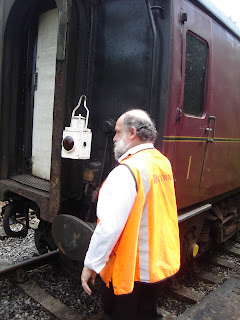Cheddleton level crossing. The crossing keeper's hut is on the left.
At the start of the day the electric lamps have to fitted to the gates, and the annunciator and signal lights switched on and checked. But before preparing the crossing, there may be some shunting to be done from the signal box at Cheddleton.
Cheddleton signal box frame. Only 5 of the levers are used; the extreme right hand one unlocks the frame, and can only be moved to the 'unlock' position when the key (which is on the train token) is inserted into the box at its base. This ensures that once the points are set and locked for main line running (where they remain throughout the working day) they cannot be moved as the token is on the train, not in the signal box. The two black levers control the crossover points to allow locomotives to move out of the yard or bay onto the main line, and the blue lever which is 'back' controls the facing point lock for the point in the crossover pair which is on the main line. Finally, the extreme left lever unlocks the frame north of the road crossing at Cheddleton.
The picture above shows the interior of Cheddleton box and what the levers do. The train token (which is required to be on board any train that operates on the line) is locked in a cupboard in the 'box. The crossing keeper will use his keys to retrieve the token and use that to unlock the frame and set the crossover for the locomotive to enter the main line from the yard or from the bay platform, then re-set the crossover so the 'road' is set for main line running. The frame is then re-locked and the token handed to the loco crew as 'authority to run'. That they now posses the token prevents Cheddleton points from being changed away from the 'main line running' setting as long as trains are running on the main line.
On days when two trains are running (as has been described earlier in this blog) the token is split into a 'Froghall - Consall' token and a separate 'Consall - Leekbrook' token, so that only the train in possession of the relevant token may run on the relevant section of line.
Sometimes the train crew carry out the shunting operation, sometimes the crossing keeper does it. If it is required to release a train from the Cheddleton station siding out onto the main line, the remote frame north of the road crossing is unlocked from Cheddleton frame, the points operated from the remote frame, then the remote frame is locked again by Cheddleton frame being locked.
Leekbrook tunnel, from the Cheddleton end
The crossing keeper should either drive to Leekbrook before train running starts to check no vandalism has taken place there that would affect operations, and should check that Leekbrook tunnel is clear of obstructions. Alternatively, he can walk to the tunnel from Cheddleton to check it, and also to check that the road overbridge on this section is undamaged.
The guards 'office' in the train of ex-BR MK1 coaches. The green ring placed on the handbrake wheel indicates the brake is not 'on'. It is only applied when the train is at rest and the locomotive is not providing vacuum to keep the brakes on. When the handbrake is applied, a red ring is placed on it as a reminder.
Late morning, I took a ride on the up train to Froghall with Peter Green, the Guard, in his 'office', to see the Guard's job first hand.
Our engine, the N7 tank I rode last time I here, 'with the bag in' (taking water)
at Froghall
at Froghall
At each end of the line, Peter moves the tail lamp to the other end of the train
ready for the return journey
At Leekbrook, a working party can be seen on the line to Stoke via Endon. This should open between Leekbrook and Endon later this year
My mentor on this training day is Kevin, and here's a 'train's eye view' of
Kevin at Cheddleton crossing as we approach from Leekbrook
I left the train when it arrived back at Cheddleton, and the locomotive got a new crew. Here the two drivers, one going off shift and the other coming on, have a chat.
On the Moorland & City line from Leekbrook to Cauldon Lowe, there's another crossing
to be manned when that line is in use. It is at Apesford, and Kevin drove me to have a look at it. Here is the line looking towards Cauldon Lowe, with the crossing keeper's hut on the left.
to be manned when that line is in use. It is at Apesford, and Kevin drove me to have a look at it. Here is the line looking towards Cauldon Lowe, with the crossing keeper's hut on the left.
The crossing at Apesford with the original crossing keeper's house
Picturesque station buildings at Cheddleton, with the DMU stabled in the station siding behind crossing gates. The railway has plans to re-open this siding as a station loop line, and replace the gates with proper wooden gates operated by wheel from a new signal box north of the crossing at Cheddleton.
It was an early start (08:00) at Cheddleton, and we finished about 17:45 so it's a long day. Only about five more to do and all being well I can start signaller training! We shall see!
.












No comments:
Post a Comment